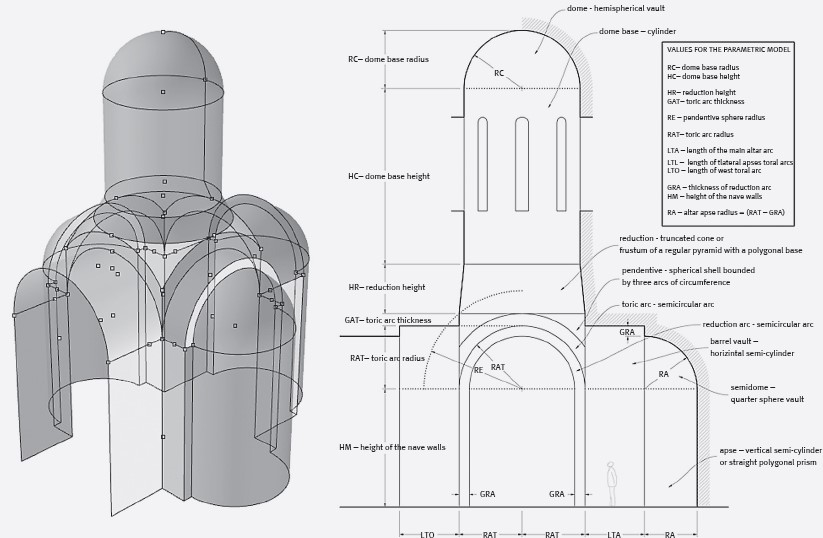Geometric Parameters to Enhance the Perception of Architectural Spaces
Case Study Applied to Romanian Orthodox Churches
DOI:
https://doi.org/10.31522/p.32.1(67).6Keywords:
architectural visualization, buildings classification, Orthodox churches, space emotions, spatial proportionsAbstract
The challenge in obtaining objective parameters for evaluating the aesthetic appeal of buildings is what we try to explain through a case study, presenting a pioneering methodology that can be applied and adapted to different architectural styles. Our focus is on a substantial investigation of Romanian Orthodox churches in the Wallachia region, which exhibit striking similarities from their early stylistic developments in the 16th century to contemporary examples. By examining the geometric relationships within their interior spaces, we aim to derive objective insights that enable an alternative classification. This classification, in turn, helps us measure the emotional impact these spaces have on users or visitors, influencing emotions based on spatial proportions. Through these relationships, we can evaluate the importance of different buildings of the same category, classify them and, objectively explain their differences. Applying the findings of this study, along with specific variables, to other architectural contexts allows us to address user preferences more effectively to enhance architectural designs by improving comfort and the quality of life.
References
Arnheim, R. and Balseiro, M. L. (2002) Arte y percepción visual: psicología del ojo creador. 2a ed. Madrid: Alianza (Alianza forma; 3).
Curcic, S. (2010) Architecture in the Balkans from Diocletian to Süleyman the Magnificent. New haven; Yale University Press.
Ghika-Budesti, N. (1927) Evoluţia arhitecturii în Muntenia. BCMI. Anul XX.
Ghika-Budesti, N. (1936) Evoluţia arhitecturii în Muntenia şi Oltenia. BCMI. Anul XXIV.
Ghika-Budești, N. (1930) Evoluţia arhitecturii în Muntenia şi Oltenia. BCMI. Anul XXIII.
Ghika-Budești, N. (1933) Evoluţia arhitecturii în Muntenia şi Oltenia. BCMI. Anul XXV.
Giménez-Mateu, L. (2016) Paràmetres geomètrics i arquitectònics de les Esglésies Ortodoxes Romaneses a la regió de Valàquia. Edited by U. P. de Catalunya. Universitat Politècnica de Catalunya. Available at: http://hdl.handle.net/2117/96114.
Giménez-Mateu, L., Navarro, I. and Cabrera, A. (2016) ‘Aproximación de superficies para la ejecución de bóvedas tabicadas’, EGA Expresión Gráfica Arquitectónica, 21(27 SE-Artículos), pp. 220–231. https://doi.org/10.4995/ega.2016.4742
Jabi, W. and Potamianos, I. (2016) ‘Parameterizing the Geometry and Visualizing the Lighting Method of Byzantine Church Domes BT - Digital Heritage. Progress in Cultural Heritage: Documentation, Preservation, and Protection’, in Ioannides, M. et al. (eds). Cham: Springer International Publishing, pp. 171–183. https://doi.org/10.1007/978-3-319-48496-9_14
Kalligas, M. (1946) He Aisthetike tou Chorou tes Hellenikes Ekklesias sto Mesaiona [The Aesthetics of Space of the Greek Church in the Middle Ages]. Greece: Athens.
Mango, C. (1991) ‘Approaches to Byzantine Architecture’, Muqarnas. New Haven: E. J. Brill, 8, pp. 40–44. https://doi.org/10.2307/1523151
Moutsopoulos, N. K. (1962) ‘Harmonische bauschitte in den kirchen vom typ Kreuzförmigen innenaus im griechischen kernland.’, 55(2), pp. 274–291. doi: https://doi.org/10.1515/byzs.1962.55.2.274
Ousterhout, R. G. (1999) Master builders of Byzantium. Princeton, N. J.: Princeton University Press.
Striker, C. L. (1995) 'Applied Proportions in Later Byzantine Architecture' in Borkopp, B. Schellewald, B. Theis, L. Studien zur byzantinischen Kunstgeschichte: Festschrift für Horst Hallensleben zum 65. Geburtstag, in Hakkert, V. A. M. (ed.), pp. 31-37.
Zhang, Z., Fort, J. M. and Giménez-Mateu, L. (2023) ‘Exploringthe Potential of Artificial Intelligence as a Tool for Architectural Design: A Perception Study Using Gaudí’s Works’, Buildings. https://doi.org/10.3390/buildings13071863

Downloads
Published
How to Cite
Issue
Section
License
Copyright (c) 2024 Fco.-Javier González-Pérez, Omar-Fabrisio Avellaneda-López, Marilena Christodoulou, Luis Giménez-Mateu

This work is licensed under a Creative Commons Attribution 4.0 International License.
Copyright (c) 2021 authors and journal.
This work is licensed under a Creative Commons Attribution 4.0 International License.
Authors who publish with this journal agree to the following terms:
In agreeing this form, you certify that:
- You read the ethical codex of the PROSTOR available at journal web.
- You submitted work is your original work, and has not previously been published and does not include any form of plagiarism.
- You own copyright in the submitted work, and are therefore permitted to assign the licence to publish to PROSTOR.
- Your submitted work contains no violation of any existing copyright or other third party right or any material of an obscene, libellous or otherwise unlawful nature.
- You have obtained permission for and acknowledged the source of any illustrations, diagrams or other material included in the work of which you are not the copyright owner.
- You have taken due care to ensure the accuracy of the work, and that, to the best of your knowledge, there are no false statements made within it.
- All co-authors of this submitted work are aware of, and in agreement with, the terms of this licence and that the submitted manuscript has been approved by these authors.






